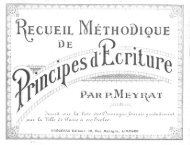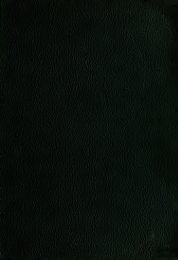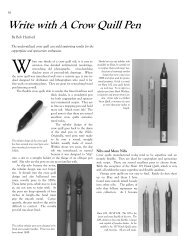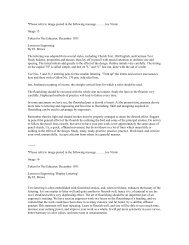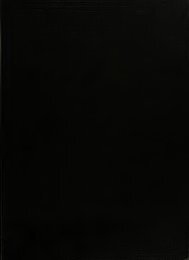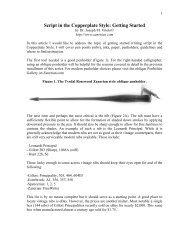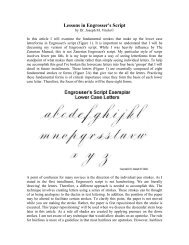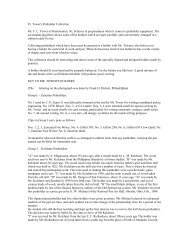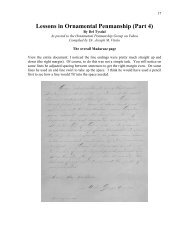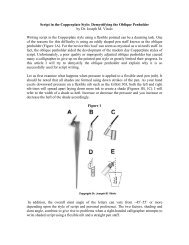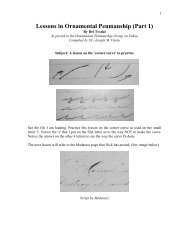The Educator (Volume 45) - IAMPETH
The Educator (Volume 45) - IAMPETH
The Educator (Volume 45) - IAMPETH
Create successful ePaper yourself
Turn your PDF publications into a flip-book with our unique Google optimized e-Paper software.
14<br />
—<br />
Some Recent Experiments in Handwriting<br />
in McKeesport<br />
Grade 1<br />
1. HandwritiiiR is started in our<br />
schools the second semester of the<br />
first year. No writing is done<br />
the first semester.<br />
2. <strong>The</strong> first semester is spent in becoming-<br />
adjusted to school conditions,<br />
in learning the first elements<br />
of reading, etc.<br />
3. A "handwriting readiness program"'<br />
is built up the first semester<br />
a. <strong>The</strong> "perception strips", or<br />
alphabet, is posted in the<br />
room and referred to occasionally<br />
as being the letters<br />
which the pupils will learn<br />
to make later in writing their<br />
names, in writing words<br />
which appear in their readers,<br />
and in writing stories of<br />
their own.<br />
b. Pupils are taught the names<br />
of lines and spaces, left and<br />
right, chalk and erasers, etc.<br />
c. Teachers study the handedness<br />
of their pupils. <strong>The</strong><br />
handedness of pupils is never<br />
changed.<br />
d. Pupils are taught to read<br />
numbers, and to write on the<br />
board from one to ten.<br />
4. Beginning the second semester, a<br />
few fundamental exercises are<br />
taught:<br />
a. <strong>The</strong> retraced line<br />
b. <strong>The</strong> "over-swing"<br />
c. <strong>The</strong> "under-swing"<br />
d. <strong>The</strong> two-space oval<br />
5. All writing the first nine weeks<br />
is taught on the blackboard. We<br />
believe in large writing for beginners.<br />
G. We have pupils read more cursive<br />
than they write.<br />
a. <strong>The</strong> aim is to get the transition<br />
from print to cursive.<br />
When pupils do not recognize<br />
the word in cursive, it is then<br />
printed on the board, and<br />
they are told that it is the<br />
same as the one which has<br />
been written.<br />
7. Sentences are read and words<br />
from these sentences are written.<br />
a. If a letter or combination<br />
gives difficulty, the letter or<br />
combination is practiced separately<br />
and then the word js<br />
again written as a whole.<br />
8. Writing, to beginning pupils, is a<br />
new language and we believe it<br />
should be read before it is written.<br />
a. A new method in the teaching<br />
of shorthand, which is a<br />
new language to students,<br />
permits no writing of short-<br />
DR. J. H. LAWSON<br />
Supt.— McKeesport, Pa.<br />
To the Pa. State Teachers Association<br />
hand until the second semester.<br />
<strong>The</strong> first semester is<br />
spent in leading shorthand.<br />
9. After nine weeks' practice on the<br />
blackboard, pupils write on paper<br />
the same words and phrases which<br />
they have already learned to write<br />
and have written on the board.<br />
<strong>The</strong>n everything is first introduced<br />
on the blackboard before it is written<br />
on paper. Paper work supplements<br />
blackboard writing.<br />
10. In four and one-half months, or<br />
one semester, first grade pupils<br />
a. Practice all the small letters<br />
in words which are within<br />
their reading vocabulary.<br />
b. Learn and practice a few of<br />
the capital letters.<br />
c. Learn to write their names<br />
(first and last).<br />
d. Write with ease and enjoy<br />
writing.<br />
e. Spell from sight every word<br />
written.<br />
IL <strong>The</strong> writing class is "socialized".<br />
Pupils help each other, and a<br />
stranger going into a class during<br />
a practice period would never<br />
recognize it as the traditional<br />
writing class.<br />
12. We are much pleased with the<br />
"carry over" into the second grade<br />
and also with the pupils' readiness<br />
to attack the writing.<br />
We find that we can accomplish as<br />
much in writing in one semester with<br />
these methods as we formerly did in<br />
two semesters. We find less expenditure<br />
of eff^ort on the part of the<br />
teacher in teaching writing and less<br />
strain on the part of the pupils in<br />
learning it than there was when we<br />
tried to teach it at the beginning of<br />
the term when so many new things<br />
are being introduced.<br />
NEEDLESSLY HANDI-<br />
CAPPED<br />
<strong>The</strong> pupil who enters the<br />
business world unable to<br />
write rapidly and well is unnecessarily<br />
and needlessly<br />
handicapped. It is not necessary<br />
that these pupils<br />
write each letter perfectly,<br />
but they should have the<br />
ability to obtain a rating<br />
between 70'; and 80% with<br />
a speed of approximately 80<br />
letters per minute.<br />
—<br />
Seventh and Eighth Grade<br />
Handwriting<br />
1. Our seventh and eighth grades are<br />
departmentalized with one or two<br />
teachers in each building teaching<br />
the handwriting.<br />
2. Two periods of 25 to 30 minutes<br />
each per week are spent on formal<br />
drill in handwriting.<br />
3. <strong>The</strong> supervisor of handwriting is<br />
concentrating this term on the<br />
grammar grade classes<br />
a. She visits each of these rooms<br />
once each month (on her regular<br />
schedule and oftener if<br />
necessary.)<br />
b. During these visits the supervisor<br />
(1) may teach the lesson<br />
(2) she may observe the<br />
pupils' work as the regular<br />
teachei' conducts<br />
the class.<br />
(3) consult with the teacher<br />
about her work in<br />
handwriting.<br />
(4) she checks any written<br />
work which the pupils<br />
may have done—this<br />
m ay be pen-and-ink<br />
work, pencil work, work<br />
prepared for any teacher<br />
other than the teacher<br />
of handwriting.<br />
(5) she may give individual<br />
help, diagnose and suggest<br />
remedies.<br />
4. In the formal drill work, all the<br />
available blackboard space is utilized<br />
by the pupils. While some of<br />
the class are writing at their desks,<br />
other pupils write the same lesson<br />
on the blackboard.<br />
We believe the blackboard is for the<br />
use of the pupils.<br />
a. This enables the teachers to<br />
give more individual help than<br />
can be given when all pupils<br />
write at their desks.<br />
b. <strong>The</strong> writing lesson becomes socialized<br />
because pupils criticize<br />
each others work and suggest<br />
remedies.<br />
Pupils strive for the approval<br />
of their classmates by producing<br />
good writing and showing<br />
improvement.<br />
<strong>The</strong>y learn to give and to take<br />
criticism kindly.<br />
c. A good attitude towards the •,<br />
writing thus prevails. i<br />
(Continued on page 17) i<br />
|



